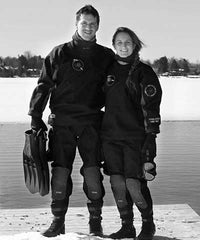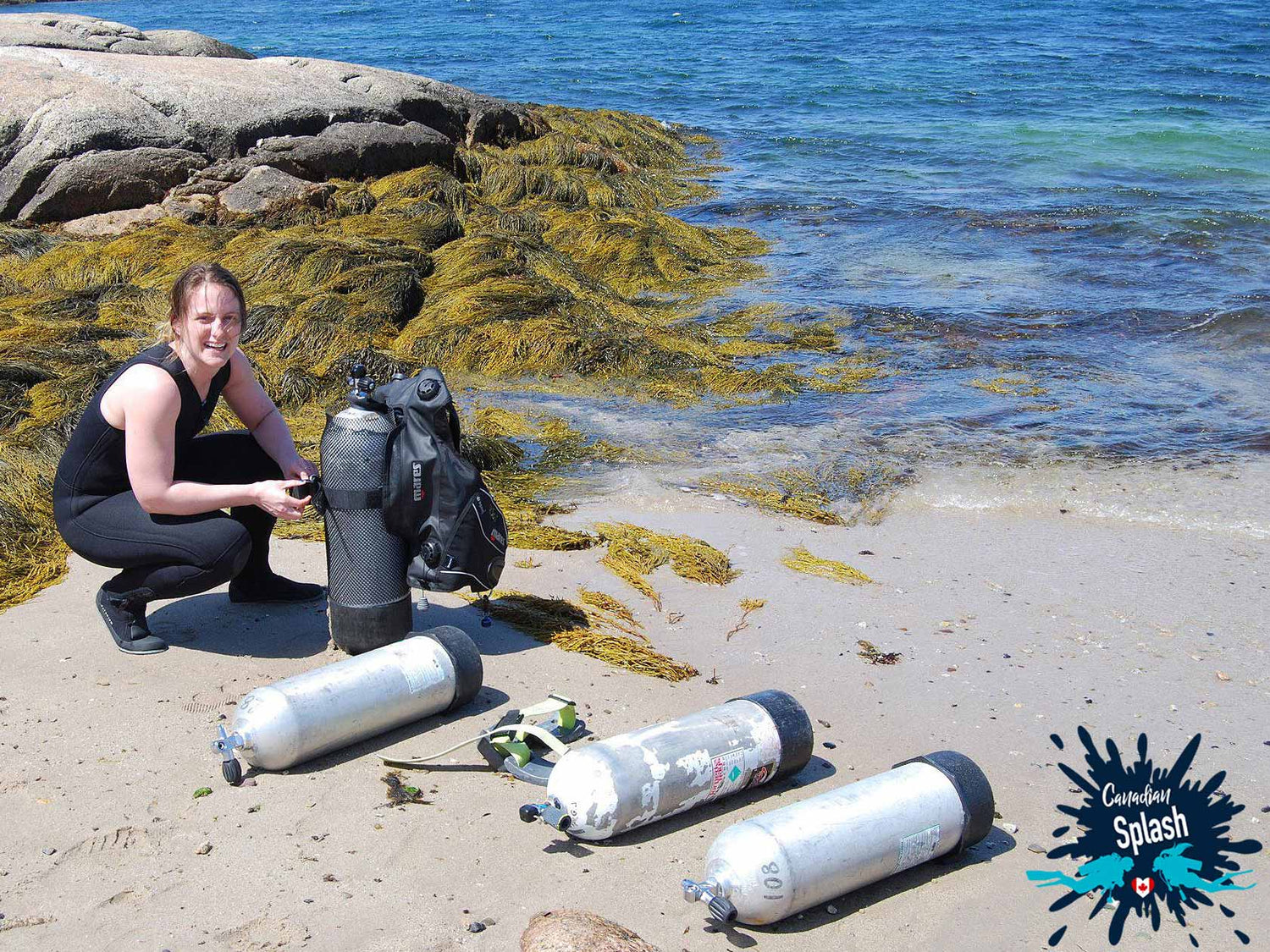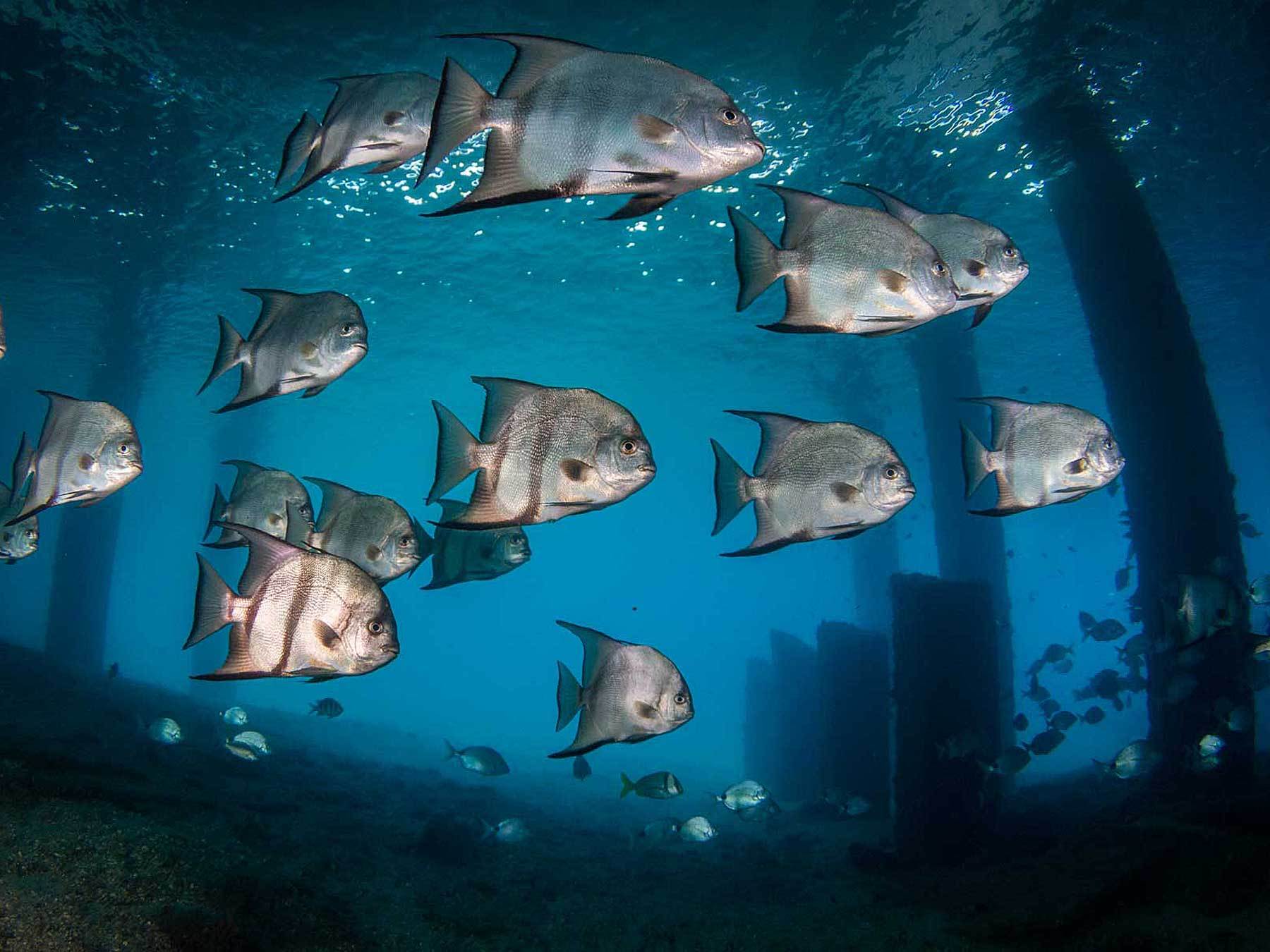By Ali Postma
When you think of a place in your home country that makes your heart happy, what comes to mind? For my husband Joey and me, that place is Nova Scotia.
This past summer, while on our adventurous mission to scuba dive every province and territory of Canada, Joey and I were brought back to Nova Scotia, our good old maritime stomping grounds. Having previously lived in the province’s capital city, Halifax, for the better part of seven years, it’s always a welcome change heading back to savor the down-home roots and salty sea air.
From the arts and culture to the North Atlantic ocean, and everything in between, there are many different ways to experience Nova Scotia. But being a peninsula surrounded by water, where the seashore is never more than a heartbeat away, anything water-related ranks high on the list. The tourism tagline for the province is after all - Canada’s ocean playground.

The glittering blue water and the panoramic ocean scenery of Nova Scotia are some of my favorite parts about the province.
Shore Diving within Halifax
The coastal municipality of Halifax is the bread and butter of life in the Maritimes. Having a growing population of over 400,000 residents, this city is one of the most populous places on Canada’s Atlantic coast.
In terms of scuba diving, there are four well-known sites to head underwater within the immediate city: Africville, the Dingle, Point Pleasant and Ferguson’s Cove. All sites have good parking availability and easy access to the water. This is pleasantly convenient considering no diver enjoys trekking heavy gear across absurd distances.

Although it may not look like much, this sand lance was incredibly tricky to photograph. They are wicked fast fish that will drop beneath the sand at the smallest hint of an intruder.
Of Halifax’s four dive sites, our favorite is Africville, found on the south shore of the Bedford Basin. Beneath the Basin’s rippling water, Africville offers anemones, anemones, and more anemones scattered all over the place. They are anchored on the rocky escarpment and even find a way to secure themselves to the mucky bottom. There are so many, it’s like swimming through a blossoming garden in the springtime.
Looking past the numerous pink, white and green wisps of anemone tentacles, Africville also has tonnes of macro critters. Snails, crabs and sea stars fill the voids between anemone stalks. As do ribbons of kelp and other vegetation.
Where fish are concerned, it’s not uncommon to find the occasional sculpin and flounder blending in with the busy surroundings. And if you swim around really slowly and carefully, your eyes might also spy an itsy bitsy white-and-red-colored nudibranch.

The best thing about sculpin is that they typically have no fear of divers. They will literally let you swim up millimeters from their face before sauntering away.
Shore Diving St Margarets Bay
As much as there is a lot to love about Nova Scotia’s capital city of Halifax, there is also much to be said about life and diving beyond the city limits.
St Margarets Bay is a south shore community about 30 minutes drive outside of Halifax. It provides yet another reason to fall head over fins in love with the province. The community is formed of the Chebucto and Aspotogan Peninsulas and comprises the world-renown Peggy’s Cove lighthouse.
A picture-perfect road hugs the winding shoreline of St Margarets Bay. This road follows the coast and affords some of the best ocean vistas south of the big city. It also offers more shore diving locations than I can count.

Rock crabs come in different sizes and with various shell-shades of red. I was lucky enough to find a small one dwarfed by the green dead man’s finger providing a nice contrast in color for this shot.
Some of the best dive sites along St Margarets Bay include Paddy’s Head, Cranberry Cove, Birchy Head, and the Lodges. And that’s only naming a few. The reality is, every dive site hits a home run in this part of the province.
Thanks to the relatively sheltered location, it’s not very often that you can’t dive in St Margarets Bay. When those few and far between days happen - trust me when I say - you likely don’t want to head out diving anyway.
The bottom profile of the bay’s dive sites consists of sand and gravel with larger rocks and boulders scattered sporadically. Coating the larger rocks is a hearty layer of kelp, rockweed, moss, and coralline algae, creating a perfect environment for animals to thrive. Zesty macro life claims its territory amid the crispy plants and won’t hesitate to defend their home against unwelcome visitors. Some of the most interesting and photogenic small critters I look for are hermit crabs, rock crabs, gunnels, nudibranchs, chitons, and sculpin. When I get lucky, I also occasionally get to enjoy photographing a sea raven or a gumball-size spiny lumpsucker.

One of the things any new diver loves about diving in Nova Scotia is the lobster. They are all over the place and will not hesitate to rear their claws and face off with you.
Cape Breton Island
If you're in Nova Scotia and you like shipwrecks, Cape Breton is the place to be.
Cape Breton is defined by its craggy cliffs and highland overviews. This northern island is separated from the Nova Scotia Peninsula by the Strait of Canso and connected through a single man-made causeway. From Halifax it takes about 5-hours by car to reach this more secluded part of the province.
Cape Breton is littered with shipwrecks along the coastline. Here divers will find wrecks-a-plenty. While some shipwrecks can be reached from shore, because the shoreline drops precipitously, inflatable diving is not only practical but preferable. Divers be warned: the weather and wind play a big part in the success or demise of your dive trips.
Some of the highly recommended Cape Breton wrecks are the 17th century Le Celebre wreck at 33 meters (108 feet) or the SS Arrow located 15 meters (50 feet) below the surface.

The plates and etchings on the shell of a chiton are exquisite to look at up close. Each one appears to be unique in some way.
Good old, Nova Scotia - my home away from home. Canada’s ocean playground.
Every time I visit this neck of the woods, I’m quickly reminded why I love this little corner of my country so much. Good people, good scenery and good diving. Until next time Nova Scotia...
 Brought together by their love for being in the water, Ali and Joey have been proudly sporting a neoprene wetsuit for the better part of a decade. Following their passion, Ali and Joey now live a life less ordinary – working, traveling and of course scuba diving. Through writing and photographing their dive adventures, they hope to help people fall in love with the underwater world, all while instilling knowledge and respect for the animals that live there. In their recent project - Canadian Splash - Ali and Joey will be traveling and diving all over Canada showcasing the beauty, wonder, and fragility hidden beneath the water in their home country.
Brought together by their love for being in the water, Ali and Joey have been proudly sporting a neoprene wetsuit for the better part of a decade. Following their passion, Ali and Joey now live a life less ordinary – working, traveling and of course scuba diving. Through writing and photographing their dive adventures, they hope to help people fall in love with the underwater world, all while instilling knowledge and respect for the animals that live there. In their recent project - Canadian Splash - Ali and Joey will be traveling and diving all over Canada showcasing the beauty, wonder, and fragility hidden beneath the water in their home country.
Join Ali and Joey on Instagram, Facebook, Pinterest, and Twitter to dive Canada!
All images copyright © 2019 Ali and Joey Postma.
These images were taken using a Canon EOS Rebel SL1 camera in 200DLM/C TTL Underwater Housing with dual DS161 strobes.
Additional Reading
First Look Canon EOS Rebel SL3 250D Underwater Housing
Canadian Splash: Destination New Brunswick
Creature Feature: the Flashing Disco Clam
Best Underwater Camera System of 2019
The Best Mid-Range Camera Underwater by the Specs
Planning a Shore Diving Trip to Bonaire












![The Impact of the Fishing Industry on the Maldives [VIDEO]](http://www.ikelite.com/cdn/shop/articles/Maldivian-Tuna-Fishing_ashley-siana.jpg?v=1645885683&width=2000)
